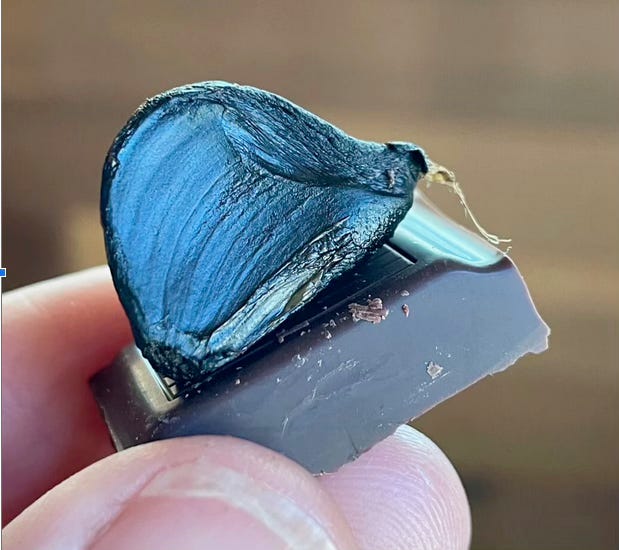Garlic season is upon us. The garlic in our garden will be ready to harvest soon and this past week, I could buy freshly harvested garlic bundles and braids at our local market. Oh, I do love a garlic braid. I used to make them every year. The thing is, they look so jaunty hanging in my kitchen that I hated to use them. And so my garlic often dried out or sprouted in my decoration. Enter preserving garlic…
My favorite way to ferment garlic is into a paste, which is convenient and ready to use with no fuss. My second favorite is black garlic and honey fermented garlic. I save the honey garlic for when I feel a cold coming on, placebo or not, it works well for me. I can’t keep the black garlic around, it is just too tasty. I really do have to hide it from my grandchildren and bring it out as a treat. Since black garlic is often misunderstood, I thought we would explore black garlic in celebration of all the garlic being harvested this summer.
Is Black Garlic Fermented?
Black garlic is often referred to as a fermented product, but contrary to popular thought, it is not fermented. This is an understandable mistake, given that it takes a lot of time and patience. During this time, the transformation is just as delicious and seemingly miraculous as any fermentation. If not fermentation, how is black garlic made?

Black garlic making is instead a long, slow cooking process under high humidity. It is still a transformation process composed of time and patience, but instead of fermentation, it is a combination of processes that happen with heat. This heat is the first hint that black garlic is not fermented because fermentation is microbial-driven transformation—yeast, bacteria, fungus—who all thrive under much cooler temperatures than the slow cooking of black garlic. For comparison, most fermentation takes place within temperatures between around 50°F/10°C to 43°C/110°F (broadly speaking). Black garlic tends to happen in the temperature range of 158°C/70°C to 176°C/80°C—way too hot for our microbe buddies to survive.
Black garlic is a beautiful synergy of different chemical reactions—enzymatic browning, the biochemical process called the Maillard reaction, and another tasty browning we know in the kitchen as caramelization. Enzymatic browning is an enzyme-driven process that we see every time we watch our picked fruit begin to turn brown. What are enzymes? Enzymes are proteins that speed up chemical reactions. As the fruit, or in this case the garlic ages, enzymes alter the phenolic compounds, and they turn brown.
The Maillard reaction is not enzymatic. This browning reaction involves reducing, or condensing the sugars (carbohydrates) with proteins or peptides. Chemically speaking this reaction is a bit complicated but we experience it all the time when we stick a piece of bread in the toaster and it pops out browned and tasty toast. Caramelization is also not an enzyme-driven reaction. Caramelization is heat (there it is again) breaking down the sugar, oxidizing it, into rich brown deliciousness.
So, all this chemistry aside, when making black garlic, we allow it to overripen, brown, and caramelize. As this happens, the garlic’s pungent, unstable compounds transform into sweet, stable compounds. The garlic becomes rich and velvety smooth with chewy leathery consistency. The garlic mellows into a sweet taffy-like "candy" that is as comfortable on chocolate as in a savory application. The flavor of black garlic is reason enough to go through the process, but it turns out that many studies are finding black garlic has high potential as a functional food. Like fermentation, black garlic's transformation also brings about health benefits. The compound that gives garlic its superpower for our immune system, allicin, is unstable. In black garlic, allicin is converted to stable antioxidants. As the garlic transforms, the unstable compounds of raw garlic are converted into stable compounds such as S-allylcysteine and S-allylmercaptocysteine, and polyphenols increase. This gives black garlic stronger antioxidant activity than fresh. Interestingly, it is in this long curing or aging process that you see the antioxidant levels rise.
Learn more about fermented garlic along with how to make black garlic and truly ferment garlic into pastes and pickles in our course Master Fermented Garlic: Garlic honey, lacto-fermented garlic, and black garlic.
Black Garlic has impressive Health Benefits
Allicin, the compound that gives garlic its pungency, is converted into antioxidant compounds like alkaloids and flavonoids as black garlic ages. Because this time it take in becoming black garlic it contains more antioxidant compounds than raw garlic.
Researchers found in 2019, while studying rats, that black garlic may also help regulate blood sugar.
Again more research is needed by scientists think black garlic may contain compounds that help safeguard the brain from memory loss and degenerative diseases, like Alzheimer’s.
The following post by
explores why garlic is good for your heart as well as how the process of making the black garlic changes its chemistry.




So timely as we just harvested our very first crop of garlic yesterday. 🧄 I’ve been wanting to make black garlic and didn’t know how so I will check out the workshop. Thanks as always for such a thorough explanation that is easy to understand. I want to try the fermented honey garlic as well.
Loved learning more about this special food!